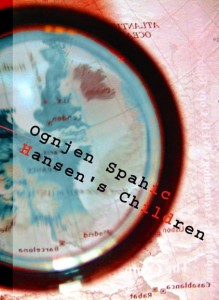Published by Istros Books 4 May 2011
156pp, paperback, £7.99
Reviewed by Elsbeth Lindner
Appalling and tragic, Ognjen Spahic’s exceptional short novel animates the misery of Ceasescu’s Romania and its inglorious fall with a metaphor fully up to the task: leprosy.
Gerhard Henrik Armauer Hansen was a Norwegian scientist who isolated the Mycobacterium leprae in 1873 and his ‘children’ are the tragic sufferers of this ghastly disease. In Spahic’s novel, it’s 1989 and a dozen of them are confined to the last leper house in Europe, an under-equipped facility located in a miserable corner of South Eastern Romania overlooking a toxic fertilizer factory.
Here our nameless narrator shares a room with fellow-sufferer Robert W. Duncan, an American intelligence officer whose career was ruined after he was captured by Communists in Berlin. But Duncan still has a few contacts in the shadowlands, notably ‘Mr Smooth’ who has it in his power to liberate the two men by supplying passports and helping them out of the country.
While this plot line lends the book a simple narrative momentum, the author smoothly interposes multiple layers of irony, history, observation and surrealism which expand its impact. Leprosy is traced across the centuries and the continent. There’s a memorable although not necessarily reliable anecdote of a leper uprising in sixteenth-century Tuscany, leading to the establishment of Lepropolis. In the twentieth-century, the leper house was the scene of further bloodshed, when the Nazis arrived in 1942 and applied their customary sanitization process of massacre, eliminating all but one of the inmates.
The leprosarium is a place apart, ‘testimony to a vast desert of fear, ugliness and disfigurement that divided us – Hansen’s children – from the rest of the world’. Similarly, there’s ‘the iron curtain that Hansen, like a devoted tradesman, had been erecting around our vile name for thousands of years’. The lepers yearn for human connection and engagement with the world beyond their confines. The political parallels are obvious but not laboured and Spahic builds an additional microcosm on top of them. Here, within the house of condemned souls, exists a society where power struggles, the memories of inmates, the daily suffering, horrific conditions and mirage-like existence on the edge of sanity – mirrored in attacks by rabid dogs and savagery between inmates – is a further vision of parallel worlds.
Yet, amazingly, there is lyricism too in minor aspects of this godforsaken landscape – birdsong, plants, the caress of the breeze on ruined flesh. Spahic even adds touches of sardonic humour, notably in a discussion of sex between two male inmates – rare enough of itself, given the effects of the disease on genitalia. Once news of AIDS reaches the lepers, attitudes to these two lovers changed considerably. ‘The nature of the new disease was misunderstood and homosexual acts per se were seen as spawning the new evil. Mstislaw and Cion were shunned…like lepers. It was kind of understandable.’
Such moments of dark wit are rare, though, and even rarer as the book spirals down into murder, suicide, uprising and reprisal. Simultaneously the terrain shifts, no longer confined to one blasted corner of the USSR but embracing the European continent itself, its long trail of suffering and its powerful new convulsions as Communism totters.
Spahic, born in Montenegro, brings authority and humanity as well as freshness of perspective to his riveting subject matter, and his book has already been recognized with the award of both the Mesa Selimovic and Ovid Prizes. New independent publisher Istros is to be thanked for introducing such compelling work. Spahic’s graphic fable deserves to be widely read.

